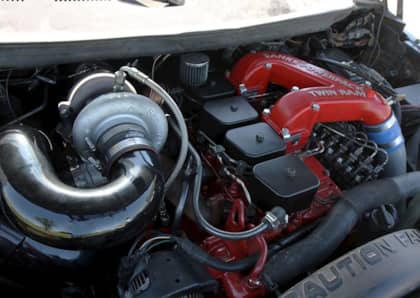Everything You Need To Know When Lowering Your Slammed Truck
There's no lack of technical guidance online about how to build a lowered truck. You'll easily find how-to's and walk-throughs that explain the nuts-and-bolts of drop spindles, lowering springs, bags, and suspension arms, and how best to install them to transform your stock pickup into a slammed truck.

It's a little harder to find advice about the 'why' of lowering your pickup, however. As with any successful automotive project, you'll need to be clear about what your goals are when lowering your pickup before you start making radical changes to your truck suspension. Build a clear roadmap from the start and you'll be much more likely to stay on budget and on schedule, and end up with the looks and performance you had in mind from day one.
Here are the key questions and concepts anyone about to build a lowered truck needs to consider prior to turning a wrench or buying parts.
Static Or Adjustable?
One of the advantages of lowering a truck is that the larger, cargo-friendly platform offers a ton of room for adjustable ride height setups. Whether you choose to go with an air ride or a more elaborate hydraulic drop, you won't lack for space when looking to stow a compressor, hydraulic lines and actuators, and all the extra batteries you may need to power it all.

Of course, space isn't the only concern when considering a static versus adjustable suspension for a slammed truck. While the ability to raise and lower your vehicle as needed for aesthetic purposes, to clear speed bumps and curbs, or for better handling and comfort is certainly appealing, it comes at a price. Pumps, airbags, and the expertise required to install them are typically more expensive than the springs and shackles required for a static drop, and they'll also require more maintenance over the long-term.
Stance Or Handling?
There are any number of reasons why you might want to lower a pickup, but they typically boil down to either improving looks or boosting performance.

These don’t have to be mutually-exclusive goals. There are plenty of suspension setups that will erase wheel gap while also lowering your center of gravity and improving the handling of your truck. If you match spring rates with the type of driving you plan on doing, you can count on a pickup that doesn't just look good when it's parked but one that is also a blast to drive.

If stance is the most important thing, however, you'll need to keep in mind that belly-scraping truck suspensions will likely have an adverse effect on your cornering and braking capability. Less suspension travel can also mean bumping and bouncing over rough pavement, which can in turn lead to axle hop that will make it more difficult to steer or maintain a straight line on the road.
Wheel Alignment Woes
Continuing the handling theme is the question of wheel alignment. Any changes made to your lowered truck's suspension are going to have an impact on the contact patch that your tires are making with the asphalt.

Suspension geometry is a complex thing, and when you stray from factory specifications it's not unusual to end up with wheel camber that is much more negative than what your vehicle was designed to ride on, as well as different toe settings front and rear. These changes can lead to early wear on your tires, as well as reduced overall steering performance and in some cases poor straight-line stability due to bump steer (which changes your steering angle on the fly when hitting a rough patch of road).

If you're dealing with a major drop, you may need to look into installing camber plates to get full adjustability when it's alignment time.
Tire Choice Is Key
Just as a lowered truck suspension affects wheel alignment, so too does it impact the tire sizes you can run on your vehicle. If you're reducing the amount of clearance inside your fender, you'll have to make sure that the tires you choose won't make contact with your body work not just when parked, but also as a result of wheel travel while driving.

It's not only sidewall height that you'll have to consider. Changes in wheel camber and toe can put wider tires close enough to suspension components to create rubbing and chunking issues as well. Always do a reality check before ordering a set of rubber.
Ride Quality Concerns
Steering and stability can be an issue for slammed trucks, but riding just a few inches off of the ground can also have an impact on overall ride quality and comfort. As mentioned earlier, reduced suspension travel can make it difficult to absorb cracks and expansion joints in the road without transmitting vibration into the cabin.

This is especially obvious when driving on airbags that are almost completely deflated, but even a coil or leaf setup can lead to a bouncy, harsh ride on a very low pickup. Running a taller sidewall can help absorb roughness, but you may end up giving back a little bit of your drop in the process, which means it may be worth it to raise your ride instead of trying to mitigate it with tire selection.
Want to know more about the nuts and bolts of lowering your truck? Check out this feature that lays out your technical options.







